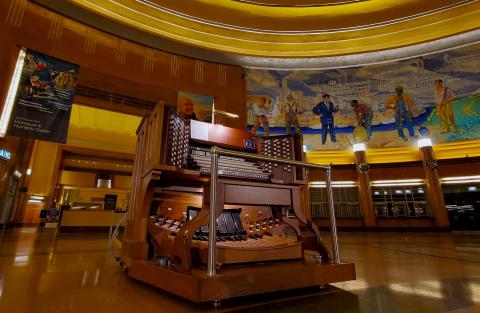Ohio has eleven historic world-class organs – tonight’s a chance to hear one

Listen to this Episode
Behind the sweeping walls of Cincinnati’s Union Terminal, something beautiful has been holding its breath.
Since the late 1980s, the Art Deco train station housing the Cincinnati Museum Center has been home to an enormous pipe organ built by the renowned E.M. Skinner company. The first concert in the station drew more than a thousand people in the 1990s.
Renovations silenced the organ in 2016. The pandemic and electrical issues kept it that way until this past November.
University of Cincinnati Music Professor Michael Unger says the organ built in 1929 is an artifact of that vibrant decade -- much like the train station constructed the same year.
“Here we have an organ that was designed for a church, and then finds its way into a gigantic rotunda with its massive sense of reverberation. And the warmth is just amplified.”
The organ's keyboard console waits in a glass display case until it's ready to be wheeled into the middle of the rotunda floor. The rotunda's curved back wall hides most of the organ's massive system of pipes and the motors which push air through them.
An instrument 'not for the faint of heart'
Harley Piltingsrud stands in the empty rotunda on a recent evening listening as a computer sends signals to the organ's pipes and expression shades to put the instrument through its paces. The Museum Center’s “organ curator” says the massive 106-foot-tall dome posed some early acoustical challenges.
"We had to actually treat part of this area with sound absorbing material to bring the reverberation rate down to five-and-a-half or six seconds," he says as he points to the portion of the dome near the terminal's entryway. "Which is similar to large cathedrals in Europe."
Piltingsrud walks behind a present-day concession area and through an unmarked door.
The hum of air compressors grows louder as he enters the room.

"The air supply for this part of the organ," he said, gesturing toward the source of the noise. "These are all pressure regulators up in here, and these are the blowers, as we call them. They're compressors that develop the pressure for operating the organ."
He points to another part of the small room that operates something like the organ's nervous system.
"This is where signals from the console come in and then disperse out to all the pipe chambers."
Piltingsrud is the driving force behind the organ, having designed its hidden systems and installed additions. The organ keeps him busy stabilizing humidity and temperature in the pipe sections.
"I've got over 25,000 hours of volunteer time in this project," he chuckled. "But I'm a physicist by training and strong in the engineering disciplines I'd say. So it fits together to a certain extent, you know?"
Piltingsrud sits in the middle of the dim, empty rotunda and admires the sounds of a Debussy piece the organ is playing.
"You have to have perseverance in any aspect of organ building. They're so involved and so time-consuming. Not for the faint of heart."
A beautiful and impressive oddity
There are actually two concert organs in the terminal. The Museum Center's main organ belonged to the Immaculate Conception Church in Philadelphia before coming to Cincinnati. The second, smaller set of pipes, known as the antiphonal division, is situated above the doorways to the Cincinnati History Museum. It was the household organ for industrialist Powel Crosley at his College Hill estate.
Combined, the setup gives listeners an immersive, surround sound experience.
Skinner was prolific, building hundreds of these organs in his lifetime. But many haven’t survived. When it comes to the remaining instruments, Ohio is blessed – there are at least eleven significant ones in the state, including in Cleveland, Columbus, Dayton and Toledo. But Unger says the one in Cincinnati is special.
“This is such a well-known organ,” he says. “It’s such a beautiful and impressive oddity that in the organ world, it’s extremely well known."
It wasn’t always so celebrated. Big, orchestral organs fell out of fashion as modernism became the order of the day later in the 20th Century. That meant Skinner organs weren’t in demand for decades, which made it possible for one to find its way to Union Terminal.
“Artistic movements saw a sort of back to basics approach,” Unger explains. “Skinner organs—maybe there was a trend of kind of seeing them for their lavish decadence. And now they’re prized for their lavish decadence.”
9(MDYwODMwNTczMDE2ODk5NTExNDAyNzM5Ng000))
- Home
- Schedules
- TV
- TV
- Local TV Programs
- Business | Life 360 with Kristi K.
- Toledo Stories
- To The Point with Doni Miller
- Listening with Keith Burris
- Ideas & Insights
- WGTE Presents
- BL360: Northwest Ohio Innovation Consortium
- Magic of the Old West End
- Freedom Means Never Surrender
- I&I: The Random Factor
- FF: National Cherry Festival
- TTP: Moms Demand Action For Gun Sense in America
- Watch Live
- Radio
- Education
- Community
- Support
- About
- Donate
- Watch Live


